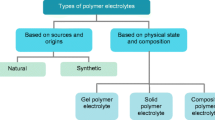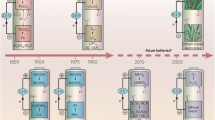Abstract
The results of a systematic study of the light sensitivity and long-term potential stability (30 days) of poly(pyrrole) (PPy), poly(3-octylthiophene) (POT), poly(3,4-ethylenedioxythiophene) (PEDOT), poly(aniline) (PANI) and plasticised poly(vinyl chloride) (PVC) containing 20% (m/m) PANI are reported. Thin films were prepared either electrochemically or by the solution casting technique. This fundamental study is of importance because conducting polymers (CP) are commonly used as ion-to-electron transduction materials in all-solid-state solid contact ion-selective electrodes. The potential stability test done in 0.1 M KCl (pH 7.5) simulates the extreme situation when the CP-based SC becomes in direct contact with water. Films prepared of a nanodispersion of PANI showed both good potential stability and insensitivity to light even under illumination with very intensive light (>105 lx). In contrary, it was observed that POT is very light-sensitive. Upon illumination with intensive light, the potential responses of POT films prepared by solution casting and electropolymerisation were 315 and 590 mV, respectively. A room light sensitivity of approximately −10 to −15 mV was observed for these films. The other CPs in this study were insensitive to room light (∼150 lx), but were light-sensitive under illumination with intensive light. The potential drift of PPy(Cl) is below −10 μV/h (3–30 days), whereas the other most stable CPs in this study had a slightly higher potential drift.










Similar content being viewed by others
References
Oyama N, Hirokawa T, Yamaguchi S, Ushizawa N, Shimomura T (1987) Anal Chem 59:258
Cadogan A, Gao Z, Lewenstam A, Ivaska A, Diamond D (1992) Anal Chem 64:2496
Sutter J, Lindner E, Gyurcsányi R, Pretsch E (2004) Anal Bioanal Chem 380:7
Bobacka J (2006) Electroanalysis 18:7
Bobacka J, McCarrick M, Lewenstam A, Ivaska A (1994) Analyst 119:1985
Paciorek R, van der Wal PD, de Rooij NF, Maj-Zurawska M (2003) Electroanalysis 15:1314
Sutter J, Pretsch E (2006) Electroanalysis 18:19
Chumbimuni-Torres KY, Rubinova N, Radu A, Kubota LT, Bakker E (2006) Anal Chem 78:1318
Rubinova N, Chumbimuni-Torres K, Bakker E (2007) Sens Actuators B 121:135
Sutter J, Radu A, Peper S, Bakker E, Pretsch E (2004) Anal Chim Acta 523:53
Hulanicki A, Michalska A (1995) Electroanalysis 7:1
Michalska A, Hulanicki A, Lewenstam A (1994) Analyst 119:2417
Momma T, Yamamoto M, Komaba S, Osaka T (1996) J Electroanal Chem 407:91
Gyurcsányi RE, Nybäck AS, Tóth K, Nagy G, Ivaska A (1998) Analyst 123:1339
Michalska A, Dumanska J, Maksymiuk K (2003) Anal Chem 75:4964
Michalska A, Appaih-Kusi C, Heng LY, Walkiewicz S, Hall EAH (2004) Anal Chem 76:2031
Konopka A, Sokalski T, Michalska A, Lewenstam A, Maj-Zurawska M (2004) Anal Chem 76:6410
Michalska A, Maksymiuk K (2004) Talanta 63:109
Gyurcsányi R, Rangisetty N, Clifton S, Pendley BD, Lindner E (2004) Talanta 63:89
Michalska A (2005) Electroanalysis 17:400
Michalska A, Maksymiuk K (2005) J Electroanal Chem 576:339
Konopka A, Sokalski T, Lewenstam A, Maj-Zurawska M (2006) Electroanalysis 18:2232
Pawlowski P, Michalska A, Maksymiuk K (2006) Electroanalysis 18:1339
Bobacka J (1999) Anal Chem 71:4932
Bobacka J, Lewenstam A, Ivaska A (2001) J Electroanal Chem 509:27
Bobacka J, Lahtinen T, Nordman J, Häggström S, Rissanen K, Lewenstam A, Ivaska A (2001) Electroanalysis 13:723
Vázquez M, Bobacka J, Ivaska A, Lewenstam A (2002) Sens Actuators B 82:7
Michalska A, Ocypa M, Maksymiuk K (2006) Anal Bioanal Chem 385:203
Sundfors F, Bereczki R, Bobacka J, Tóth K, Ivaska A, Gyurcsányi RE (2006) Electroanalysis 18:1372
Ocypa M, Michalska A, Maksymiuk K (2006) Electrochim Acta 51:2298
Vázquez M, Bobacka J, Ivaska A, Lewenstam A (2004) Talanta 62:57
Vázquez M, Danielsson P, Bobacka J, Lewenstam A, Ivaska A (2004) Sens Actuators B 97:182
Michalska A, Maksymiuk K (2004) Anal Chim Acta 523:97
Cui G, Lee JS, Kim SJ, Nam H, Cha GS, Kim HD (1998) Analyst 123:1855
Han WS, Park MY, Chung KC, Cho DH, Hong TK (2000) Anal Sci 16:1145
Han WS, Park MY, Chung KC, Cho DH, Hong TK (2000) Electroanalysis 13:955
Lindfors T, Ivaska A (2004) Anal Chem 76:4387
Han WS, Chung KC, Kim MH, Ko HB, Lee YH, Hong TK (2004) Anal Sci 20:1419
Kholoshenko NM, Ryasenskii SS, Gorelov IP (2006) Pharm Chem J 40:289
Lindfors T, Aarnio H, Ivaska A (2007) Anal Chem 79:8571
Fibbioli M, Morf WE, Badertscher M, de Rooij NF, Pretsch E (2000) Electroanalysis 12:1286
de Marco R, Veder JP, Clarke G, Nelson A, Prince K, Pretsch E, Bakker E (2008) Phys Chem Chem Phys 10:73
Lindfors T, Harju L, Ivaska A (2006) Anal Chem 78:3019
Lindfors T, Ivaska A (2007) Anal Chem 79:608
Lindfors T, Ivaska A (2002) J Electroanal Chem 531:43
Lindfors T, Harju L (2008) Synth Met DOI 10.1016/j.synthmet.2008.01.009
Lai CZ, Fierke MA, Stein A, Bühlmann P (2007) Anal Chem 79:4621
Lindfors T, Bobacka J, Ivaska A (1997) Anal Chim Acta 355:217
Li Y, Qian R (1993) Synth Met 53:149
Wei D (2007) Organic electronic materials based on poly(aniline) derivatives. Doctoral Thesis, Åbo Akademi University (ISBN 978-952-12-1865-1)
Pivrikas A (2006) Charge transport and recombination in bulk-heterojunction solar cells. Doctoral Thesis, Åbo Akademi University (ISBN 952-12-1786-3)
Bard AJ, Faulkner LR (1980) Electrochemical methods: fundamentals and applications. Wiley, New York (back cover)
Wei D, Pivrikas A, Karhu H, Majumdar HS, Lindfors T, Kvarnström C, Österbacka R, Ivaska A (2006) J Mater Chem 16:3014
Gyurcsányi R, Lindner E (2002) Anal Chem 127:4060
Wessling B (2007) Conductive polymers as organic nanometals (Chapter 1). In: Skotheim TA, Reynolds JR (eds) Handbook of conducting polymers, vol 2: conjugated polymers: processing and applications, part 1. Processing of conjugated polymers. CRC, Boca Raton
Acknowledgements
Dr. Jörg Posdorfer at Ormecon GmbH is gratefully acknowledged for the PANI dispersion (D1003). The author is most grateful for discussions with Dr. Pia Sjöberg-Eerola and Prof. Johan Bobacka concerning POT and PEDOT, respectively. Many thanks also to Prof. Ronald Österbacka at Åbo Akademi University (Department of Physics, Centre of Functional Materials) for discussions of the light sensitivity of CPs. Finally, acknowledgments to Mr. Sten Lindholm for measuring the spectra of room light and the Leica light source. This work is part of the activities of the Åbo Akademi Process Chemistry Centre within the Finnish Centre of Excellence Program (Academy of Finland, 2000–2011).
Author information
Authors and Affiliations
Corresponding author
Rights and permissions
About this article
Cite this article
Lindfors, T. Light sensitivity and potential stability of electrically conducting polymers commonly used in solid contact ion-selective electrodes. J Solid State Electrochem 13, 77–89 (2009). https://doi.org/10.1007/s10008-008-0561-z
Received:
Accepted:
Published:
Issue Date:
DOI: https://doi.org/10.1007/s10008-008-0561-z




